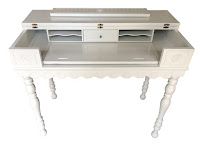 |
| Rush Chair After Replacement |
 |
| Rush Chair Before Replacement |
First I removed the old rush from the seat completely, then removed any residue and dirt before beginning the new weaved seat. Measuring the seat is the first step in the rush weaving process. You measure the front, then the back and deduct the back measurement from the front and divide by two. For this chair, it was one inch. I made a mark on each side, then began my front weave using this mark.
The rush fibre strand is attached to the left side and wrapped around the front left and right until you reach the mark you made on the front of the seat. Then you can begin adding the rush to the back of the chair using the same technique. This is a long, tedious and very strenuous process. As you weave, it’s important to pull each strand very tightly before you continue to wrap each side. Using clamps to keep the rush in place is essential to keep it taut while weaving.
The weave begins with over the left rail, up through the middle, then over the right rail, up through the middle, over the back rail and up through the middle, over the back right and up through the middle, over the back left and up through the middle then over the back rail and up through the middle, then down the front of the chair where you started and begin the entire process until your weave reaches 2/3 complete. Cardboard triangles are then fitted into each side, top and bottom to fill the gaps, then you continue to weave until you reach the center of the chair. During the weaving process you need to add new coil when you run out by tying a square knot and continuing the tying the new rush to the piece you ended with. The knot should be somewhere in the bottom so it can’t be seen from the top of the chair.
The closer you get to the center, the more tricky the weaving becomes because you can no longer pull the large coil through the center, so you must pull it single strand through the center and keep going until you fill up the hole. Then you finish it off by tying off the bottom. I completed each chair by applying clear polyurethane to protect the chair from staining.
 |
| Rush Seat Before |
 |
| Rush Seat After |






